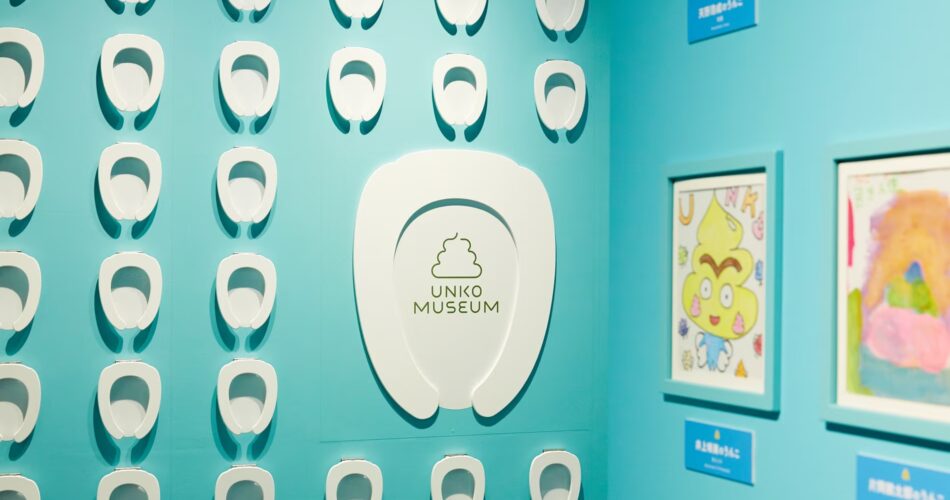The newly designed, Instagram-worthy area celebrates defecation while incorporating a cutesy Japanese flair
An immersive exhibition celebrating “adorable poop” premiered at Melbourne’s new Unko Museum. You can find yourself thinking about the significance of excrement and our relationship with it while you relax with a furry poop creature named Jenny, browse the shelves of a poop supermarket, and have a poop tea party.
As reported here, the first Unko Museum in Australia is located across the road from the former site of Melbourne’s first public restroom, which opened its doors in 1859. Over the past five years, Unko Museums have sprouted up throughout Shanghai and Japan (the word “unko” is a play on words for “doo-doo”). At $23.50 (or $18 for each child if you’re dropping the kids off), admission consists primarily of a collection of Instagrammable set pieces and a few crappy games.





The poop featured here, arranged in a play area, suspended from the ceiling, and shining sinisterly in a dimly lit hallway, embodies the quintessential soft-serve shape of poop, surpassing even the much sought-after but elusive Type 4 on the Bristol stool scale, which is described as “like a sausage or snake, smooth and soft.”
When describing the shape’s allure, Masaru Kobayashi, director of T Museum, the organization that created Unko Museum, references both the tiered pagodas of Kyoto temples and Euclid’s golden ratio.
He mentions Akira Toriyama’s Dr. Slump manga series from the 1980s, in which an android girl struggles with her insatiable drive to poke poop with sticks and finally comes across a variety of endearing sentient objects.
“For Japanese people, it is an ordinary thing to enjoy as a kind of entertainment,” explains Kobayashi. This is partly because of the kawaii style of Japan, which manages to make even “very dirty stinky things” cute. “You can find something kawaii in anything,” he asserts.
He also emphasizes how important agriculture is to Japan and how “poop as fertilizer” has helped de-stigmatize it. However, over half of Australia’s land is used for agriculture, and here, we mainly just ignore the subject or get unhealthily fixated on it.
That Unko Museum has pulled the rope in a city that was dubbed “Smellbourne” in the 19th century due to its neglect of maintaining a proper sewerage system is, in a sense, fitting.
The Unko Museum does not have any such taboos. One installation encourages viewers to stomp on colorful turds in order to earn points for a game. In another, three kids yell “poo!” into a microphone, causing one of them to light up on a screen. Although the actual restrooms are hidden at the rear, numerous others are prominently displayed. In fact, some of them even reward you with a plastic representation of your accomplishments when you sit on them and pretend to squeeze. Children are delighted, and adults giggle as they cautiously poke a turd or two. Some couples take a romantic picture while seated next to each other on the toilet.
It must be said that stigma plays a part in the 38% of Australians who report having incontinence; of these, the majority do not seek medical attention from a professional, and nearly a third say that their incontinence negatively impacts their mental health. One study found that simple praise can help one in five youngsters who struggle with stool-potty training. So picture what would happen if everyone in the room applauded as you pretended to win a toy by squeezing one out.
Nowadays, scientists are looking at how a more literal acceptance of feces—in the form of transplants—might aid in the treatment of anything from cancer to gastrointestinal issues. In 2022, Australia was among the first nations globally to grant approval for the treatment.
There’s more at risk than just our bodily well-being. The conservation biologist Joe Roman proposes using animal excrement as a strategy to address the climate catastrophe in his book Eat, Poop, Die: How Animals Make Our World, published in 2023. The vibrant color displays of Unko Museum become less bizarre as Roman relates his more than two decades of collecting whale feces. With a poetic flourish, he adds that “at times, they sparkle with scales, like the sun glinting on the water.” “Whale fecal plumes can be neon green or bright red.”
Whale scat is more than just a pretty face; it nourishes other creatures and pulls carbon from the ocean’s surface. This is just one of the many diverse ways that many animals respond to nature’s call to sustain life, repair ecosystems, and keep the earth cool.
The Pooseum, Australia’s other poo museum, is located in Richmond, Tasmania, and offers “education about defecation”—an info dump with a stronger scientific bent. You’ll discover more information at the Unko Museum.
However, Unko Museum is worth a visit if you’re looking for a lighthearted, breezy thirty minutes to mess around and snap some pictures.
Photo by Unko Museum
